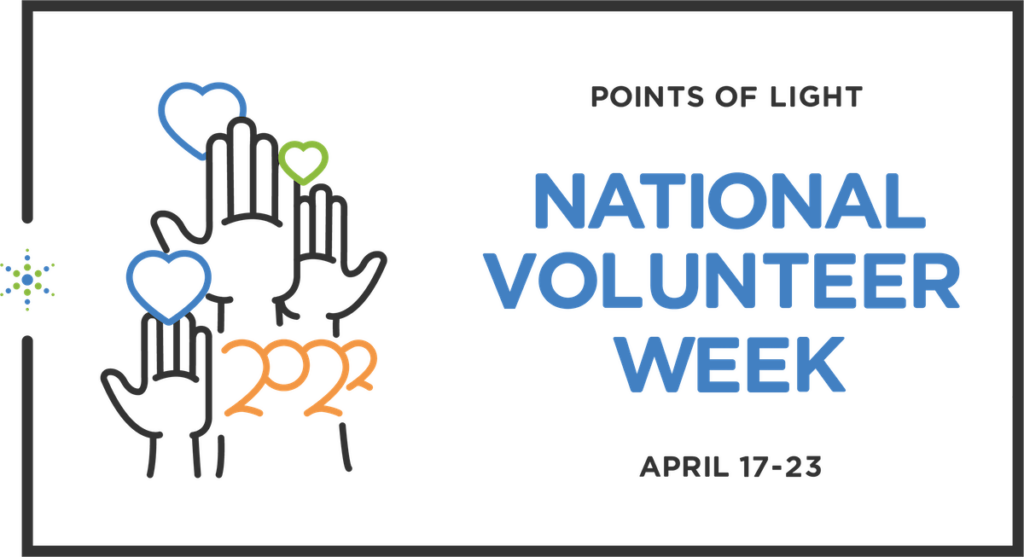 How to Get Media Coverage During National Volunteer Week: Part 1
How to Get Media Coverage During National Volunteer Week: Part 1
National Volunteer Week is next week (April 17-24) here in the US, and it’s a fantastic time to get media attention to publicly celebrate of the valuable contributions of volunteers.
Because the press is focused on volunteerism during National Volunteer Week in particular, it’s also the perfect time to leverage the media to make the public aware of your opportunities, share your volunteer appeals, and inspire your community to step up and serve.
Reporters are actively seeking sources for stories right now, So, this week and next (in a two-part blog series) we’re sharing our favorite tips and advice on how to attract the attention of the media and get coverage.
Missed our second post? Access How to Get Media Coverage During National Volunteer Week: Part 2 HERE >>
Whether National Volunteer Week falls in April for you or another month in the future, this guide will help you manage it with ease.
Engaging the help of local media to spread the word about your organization’s volunteer opportunities and achievements is a solid strategy to support your recruitment efforts. Media outlets both small and large can reach larger numbers of people with much less effort than you can.
But they need your assistance with helpful source information that is timely and newsworthy. Below are some tips on how to have a successful relationship with your local media outlets, whether they be TV, radio, print, or online.
Connect with Reporters for National Volunteer Week in Four Easy Steps
Follow these simple steps to develop long-lasting relationships with local reporters you can partner with both now and into the future.
Step One: Develop Your Personal List of Contacts
Do your research and develop a list of reporters who would likely cover your organization’s local activities. Think about different angles for your stories and pitch them to the most likely suspects.
Reporters who cover the local community and lifestyle beat are an obvious choice, but think beyond that, too. Consider the business section or other sections related to your work (e.g., health). Make sure the assignment desk and public service director (or community affairs director) of each media outlet is included in your list.
Check out the United States Newspaper Listing (or the listing for your country) for a complete list of newspapers in our area, do a web search, or reference hard copy media directories at your local library.
Also, check with the communications department at your agency to find out who they may already have contact with. Then, create a Media Contact List spreadsheet to keep track of your local contacts with whom you have a relationship.
Step Two: Do Your Homework
Follow the media people on your list. Read their stories and subscribe to their social media handles. Know what they favor and if they have opinions, what they are. Understand their reach; do they get picked up by other media outlets? Do they make guest appearances on other outlets?
The more you understand their point of view and topics they like to cover, the more equipped you will be to make a successful story pitch. This will also save you time by eliminating reporters who don’t have an interest in community events, nonprofits, philanthropy, or volunteers.
Step Three: Send Them a Press Kit
Once you’ve whittled down your list of contacts who might be interested in covering you for National Volunteer Week, send a press kit out to the reporters on your list.
Include a fact sheet about your organization and how volunteers make an impact, any previous press clippings (if they are positive), event listings, profiles of clients or volunteer team members who are willing to share their personal story, links to any other helpful community websites and info, and your contact info.
Step Four: Give Them a Call
Ask them if they received your press packet and if you can answer any questions. You can explain that you have recently been given the responsibility of media outreach and you wanted them to know you are a resource. Mention National Volunteer Week, but if this is the first time you’ve contacted them, don’t be too pushy, unless they need information right now.
Remember, you are building a relationship that you hope will last far longer than this one event, or special week-long celebration, so take the long view.
Also, register with Help a Reporter Out (HARO). Reporters use this database to connect with reliable sources with expertise in the area they are currently looking for. You will receive source requests relevant to you or your industry, expertise or personal experience. When responding to a request, include answers to question, your bio and organization information. If the journalist is interested, they’ll get in touch.
Bonus Step: Meet with Key Reporters Before National Volunteer Week
If you are able to develop relationships before National Volunteer Week, invite reporters to meet with a few people on your local team for lunch or coffee. If possible, have them tour your facility. At this point you are supplying info only. You may also want to ask whether they think you should meet with the editorial board, too.
In addition to proactively building relationships with reporters, it’s also important to have a story to tell that will interest them and that is newsworthy. While you may think a story is compelling, remember that journalists and media outlets have their own editorial directions that they must fulfill.
What Makes a Good Story for National Volunteer Week?
There’s no doubt that the media likes to cover conflict, but they also like to cover heartwarming human-interest stories. This makes National Volunteer Week a perfect topic for coverage.
Focus on the positive, rather than the negative. If there are challenges that your volunteers help clients or your community overcome, it’s OK to share them. But be sure to share how your organization is helping people avoid them, too. Always pitch volunteers as part of the solution. Complaining about the state of things won’t put your organization in the best light, even if what you are saying is true.
Also, reporters want to answer the basic questions — who, what, when, where, and why? So, make sure you have anticipated their questions and have answers at the ready. Also, have the contact information for people who are willing to be interviewed, and any possible photos (with captions) ready before they are requested.
A good story to be pitched to a reporter starts with a great hook. Here are a few reasons your news might be newsworthy:
- Is it new, groundbreaking, important (i.e., innovative ways volunteers are involved)?
- Is it different from anything else out there (i.e., community assistance or volunteer opportunities that no one else does in your area)?
- Is it part of a trend (i.e., an increase in volunteerism in the local area)?
- Is it a local angle on a national story (i.e., how local organizations are celebrating National volunteer Week or Global Volunteer Month)?
- Is it a dramatic personal story (i.e., how one of your clients overcame a huge challenge with the help of a volunteer)?
- Is it an anniversary story (i.e., your volunteer program’s anniversary, a long-term volunteer’s anniversary, etc.)?
- Is it a fresh slant on an old story (i.e., new ways volunteers are making a difference in the modern world)?
The most compelling stories are about real people. Share stories about real life clients (or customers) and volunteers to all your media outreach materials (with their permission, of course). Try to find clients who are willing to be interviewed about how they overcame their challenges. Focus on the client’s struggles and achievements and how they found success with volunteer support. Keep it based on people, not what your organization or program is about.
Making a Pitch to Reporters
If you have taken the time to build some key relationships with reporters (see above), you will have a better chance at getting coverage.
Don’t be intimidated by making calls to reporters. They take many calls just like yours every day. After all, a reporter’s job is to find stories in your community. You have them!
Just make sure you have something real to pitch and are prepared to provide all the support they need to bring it to fruition, including interviews and images or the opportunity to get them.
When you are ready, call the reporter and be up front that you are making a pitch. It’s OK. They get them all day long. Call print, TV, and online media between 10am and 2pm. They will more likely be at their desk. Call radio outlets between 7:30 and 8:30am.
Prepare a 30-second pitch. Make sure you have your talking points written down and rehearsed. Also, be sure you have added info, resources, and interview contacts ready.
Your pitch should focus on the news, not your organization. It should also focus on an angle that would interest this particular reporter. If you’ve done your homework, you’ll know what their interests are.
Your call might sound something like this (feel free to adjust the messaging if you are not a direct service agency):
Hi, I’m [insert your name] from [insert your agency name]. I have a good story for you about how volunteers are making a difference in the lives of {insert who their work benefit]. It would be a great story for National Volunteer Week (April 17-24). Is this a good time to talk?
We have been engaging volunteers here in [insert your town or region’s name] for over almost [insert number] years. As the community rebounds from COVID, we’re seeing a growing interest in volunteerism, but also a growing need for [insert client help provided] services. We have about [insert number] of people in need in our community, and our volunteers help [insert number served] each year. Right now, we have an urgent need for volunteer support.
So, we’re putting together public education campaigns to get the word out about how volunteers can help. We thought National Volunteer Week was the perfect time for this kind of story.
Then, stop talking. Take a breath and see if they have more questions. Because you’ve pitched it as newsworthy, you’re going to need to deliver. Offer to help in any way to make their job easier. Be ready with added facts and statistics to support your story, as well as other contacts.
Make sure you have volunteers ready to be interviewed about what people are confused about. And make sure those who will be interviewed are trained to stay on point. Your job is to raise awareness about volunteerism and your good cause, not to bash people who don’t volunteer, or funders who don’t support you, or policies that make your work more difficult.
Also, make sure the reporter has your social media handles and get theirs. If they ask, be ready to share how many followers you have and that you would be happy to amplify their piece when it is published.
Once you’ve made the pitch, let it go. Don’t nag or pester. Let the reporter get back to you with questions and be available by cell phone 24-7. They are working on deadline and need your cooperation.
If reporters call you, great! Stick to your talking points, and don’t let them lead you off on a tangent. Also, make sure you work within their deadlines. They’ll be more likely to consider you a reliable source and call you again.
FREE National Volunteer Week Tool: Volunteer Thank You Letter Sample Cheat Sheet
Volunteer appreciation doesn’t have to be difficult. And, often the simplest ideas are the most heartfelt and appreciated.
If you’re looking for quick ideas on how to write creative, meaningful thank you notes, check out our free Volunteer Thank You Letter Sample Cheat Sheet!
Use this guide to write notes of appreciation for volunteers. Don’t wait until the end of a big project or event. You can also send thank you notes to spouses, partners, bosses, and kids for supporting the volunteer in their community work!
The Cheat Sheet includes a list of research-based motivations you might want to reinforce in your letters. Also, we share our Four-Part Power Volunteer Thank you formula and offer an example of how to use it in a thank you letter.
If you struggle to know just what to express in your letters or are looking for a little extra inspiration, this freebie is for you!







